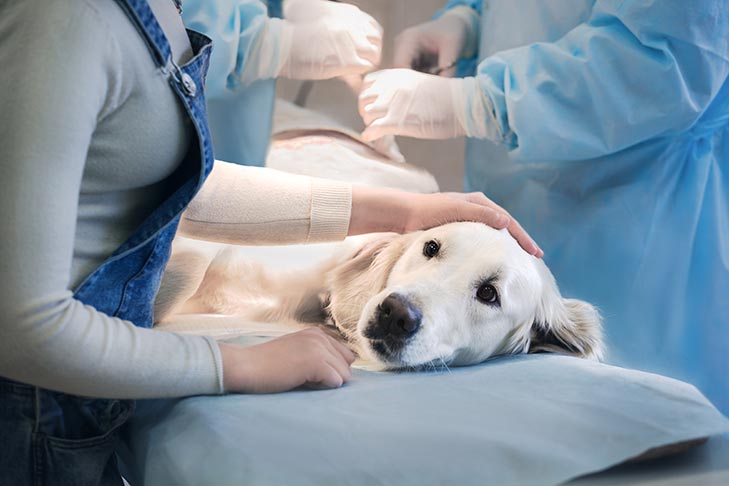
Intervertebral disk disease (IVDD) in dogs is a neurologic condition in which the protective material around the spinal cord has undergone some kind of change. The result can be pain, dysfunction, or paralysis.
Dogs with IVDD may exhibit a variety of symptoms, including limping, dragging their legs, or hunching their back. If you notice any of these, bring your dog to your vet immediately to avoid further injury or loss of function.
Here’s what to know about IVDD, including the different causes and types, symptoms to keep an eye out for, and possible courses of treatment.
What Is Intervertebral Disk Disease in Dogs?
Like humans, dogs have a spinal cord. Spinal cords consist of nerve tissue that connects the brain to the lower back and transmits nerve signals between the brain and body. Surrounding the spinal cord are bones called vertebrae. In between them is a jelly-like disk, which acts like a cushion.
You may be familiar with the fact that people can have a slipped disk or herniated disk. Something similar can happen to dogs. “If there’s any kind of damage to the vertebrae or if a disk moves, it causes pressure on the spinal cord,” says Dr. Amy Attas, VMD. “This condition is what we consider intervertebral disk disease when that cushion — i.e., the disk — either bulges next to the spinal cord because of inflammation or ruptures because it’s damaged.”
When there is complete compression of the spinal cord, it causes paralysis and requires immediate veterinary care, Dr. Attas explains. Partial compression of the spinal cord can lead to pain and nerve damage.
What Causes IVDD in Dogs?
The type of IVDD your dog is dealing with depends on what part of the spinal cord has been affected. Cervical IVDD occurs when the neck is affected. Thoracolumbar IVDD involves the chest and mid to lower back region. Sacral IVDD involves the area near the dog’s tail.
Any dog can develop IVDD. But some breeds may be predisposed to this condition because of their anatomy. For instance, breeds such as Dachshunds, Pembroke Welsh Corgis, and Basset Hounds have short legs and a long body that is low to the ground. “If these dogs were trucks, they would be 18-wheelers because they need extra wheels to carry them, but they only have four legs,” Dr. Attas explains. So there’s a long area of their body that isn’t getting a lot of support. If dogs with long bodies and short legs are overweight, they may be at elevated risk for developing IVDD in the thoracolumbar area because of the added pressure on the spine.

However, recent IVDD research suggests that body shape alone doesn’t necessarily make dogs prone to IVDD. There may be a genetic component to IVDD predisposition, even among dogs of the same breed. For example, there appears to be less of a risk of IVDD in standard wirehaired Dachshunds, as opposed to standard and miniature longhaired and smooth-coated Dachshunds.
Large dogs like Labrador Retrievers, Doberman Pinschers, and German Shepherd Dogs are also prone to a degenerative form of disk disease. As Dr. Attas explains, the disks that are meant to cushion the spine can become brittle with age. Little pieces of the disk can dry out and break off, causing damage to the spinal cord.
Another cause of IVDD is an injury that results from jumping or experiencing a hard landing. One moment, your dog can be playing and jumping, and then they may suddenly cry out in pain. The force of the movement can damage a disk, resulting in acute pain and pressure on the spinal cord. Sometimes, the dog’s personality changes because they can no longer participate in activities they once enjoyed. In other cases, dogs can wake up one day in pain without any obvious signs of injury.
What are the Symptoms of IVDD in Dogs?
Symptoms of IVDD vary and may include the following:
- Pain
- Anxiety
- Reluctance to walk
- Limping
- Lameness
- Difficulty putting their body in a position that allows them to poop
- Avoiding stairs
- Avoiding jumping on furniture (if they usually do so)
- Looking drunk while walking
- Dragging their hind legs
- Arching their back like a cat
- Refusing to eat because of pain
Pressure on the spinal cord can make it difficult for dogs to urinate or have a bowel movement. You might see your dog arching their back to try and relieve the compression on the spine and make themselves more comfortable.

“All of these symptoms require immediate veterinary attention,” Dr. Attas says. “The symptom that is an absolute emergency is if the dog is unable to walk.” When you call the vet, they might ask you to see if your dog can take a few steps. What you’ll need to do is place your arm under your dog’s belly to support their weight.
If your dog is unable to walk, this means that “there is so much compression on the spinal cord,” Dr. Attas explains. She adds that if the condition isn’t immediately treated with surgery, it can become irreversible.
What Treatments for IVDD in Dogs Are Available?
Since there are many factors involved in causing IVDD, the treatments tend to vary as well. “The one thing we can’t do is ignore it,” Dr. Attas emphasizes. “A minor problem that could be completely fixed with rest and anti-inflammatory medication can become a much more serious problem if people don’t pay attention to it.”
Cervical IVDD is especially concerning because damage so high up in the spinal cord will affect more than just the dog’s hind limbs. Surgery in this location tends to be more complicated and carries greater risks to the dog if it doesn’t go as planned. “Oftentimes a traumatic injury in the cervical region can be a life-ending situation,” Dr. Attas says.
For some dogs, the chance to run and jump is just too tempting, even when they’re in pain. If they have a disk that is mildly inflamed or partially extruded, what they really need is rest. Your vet may prescribe anti-inflammatory drugs to reduce pain and inflammation. These medications can be steroidal or non-steroidal, but you should use them only as directed by your vet.

“I can’t stress enough how rest really makes a difference,” Dr. Attas says. Sometimes this means putting your dog in a crate or a playpen where they can’t walk around much or jump on anything. The vet might also give your dog mild sedation to keep them as quiet as possible until the inflammation decreases.
In situations where a dog’s condition is deteriorating or if they’re no longer able to walk, the vet will do an assessment called deep pain where they apply a noxious stimulus to the tip of the toe. “If there is no response at all, that has to be fixed immediately with decompression and those dogs would go to surgery,” Dr. Attas says. “We actually remove a portion of the backbone — those little vertebrae — to relieve compression of the spinal cord and allow it to heal.”
Without surgery, compression of the spine can cause irreparable damage. “Because there’s no place for this swollen cord to go, eventually it dies, which leads to permanent paralysis,” she says. Depending on where the compression is located, paralysis could affect the hind limbs. If the dog’s front limbs are strong enough, the vet may recommend a mobility device (like a cart) to help your dog get around.
What Happens if Your Dog Is Paralyzed?
Even if a dog is no longer in pain, being paralyzed can set off a lot of medical issues and complications. If the paralysis is higher up along the spine, it can affect the nerves that control urination and defecation. Dogs that can’t empty their bladder properly can suffer from urinary retention and urinary tract infections.

“Dogs who become incontinent will need to have aid from their families to express their bladder,” Dr. Attas says. “They will just pass feces from the colon, making it a lot harder to have good hygiene.” In addition, the vet will need to examine your dog regularly for signs of infection and treat them with antibiotics as needed.
These dogs need constant bathing and may get skin infections from lying in their own waste. If you have a larger dog, helping them into a harness or getting them in and out of the bathtub can be more difficult.
“Sometimes the management of the pet is more than a family or single person can handle,” Dr. Attas says. “There’s a lot of guilt in that because the dogs are still friendly and loving, but their bodies are not working.” Her advice is to speak to your vet about what’s right for your dog and your family.
With IVDD, catching it early can help avoid a recurrence. The sooner the vet examines your dog and administers treatment, the better your dog’s chances of recovery.
This article is intended solely as general guidance, and does not constitute health or other professional advice. Individual situations and applicable laws vary by jurisdiction, and you are encouraged to obtain appropriate advice from qualified professionals in the applicable jurisdictions. We make no representations or warranties concerning any course of action taken by any person following or otherwise using the information offered or provided in this article, including any such information associated with and provided in connection with third-party products, and we will not be liable for any direct, indirect, consequential, special, exemplary or other damages that may result, including but not limited to economic loss, injury, illness or death.

